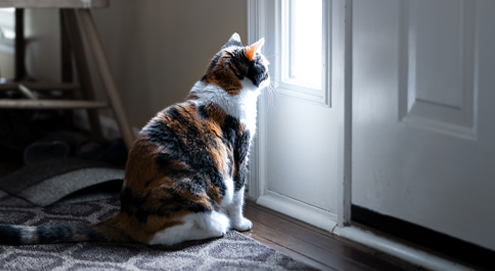Have you taught your pet to be home alone after corona?
Written by |
A question that is becoming increasingly important as normal life after the Corona lockdown approaches. This means that most of us will go back to work, resulting in leaving our pets home alone. But is your pet prepared for this? Can your dog or cat stay home alone? In this blog post, we will give you tips about how to teach your pet to stay home alone.

Leaving your dog alone
Dogs are pets that need to learn how to stay alone. This is an important part of raising a puppy. During the covid period, many people have been home a lot. There were possibly only a few moments where your dog had to stay by itself. It will therefore take some time for everyone to get used to normal life again. This certainly applies to dogs that were brought into the house as a puppy during the corona crisis. They may never have learned to be home alone. But also dogs that were used to being alone, will have to relearn this when their owner has been home a lot during the corona crisis.
Separation anxiety in dogs
To prevent problems, it is sensible to start teaching your dog to stay at home alone. You can build this up slowly. If you go too fast, you run the risk of unwanted behaviour and separation anxiety in your dog. Unfortunately, the latter occurs a lot with dogs. Separation anxiety causes a lot of stress for the dog, but also the owner. Unfortunately, you cannot always prevent separation anxiety, but by building up your dog’s ability to stay alone, you can reduce the chances of this happening.
How do I teach my dog to stay home alone?
When teaching your dog to be alone, it is important to start with short periods of time and keep a close eye on how your dog reacts to this. If necessary, use a camera to see what your dog does in your absence.
It often makes a difference whether your dog has learned to be home alone before or has never learned this at all. For dogs that were already used to being alone at home before the corona, you can often start with periods of 5 to 10 minutes alone. For dogs that have never been alone before, you will need to start by leaving them alone in a different room. Use our blog article Leaving your puppy alone for more explanation on how to teach your dog to be home alone (again).
How do you teach other animals to be home alone?
It can be quite a transition for other animals to have to stay at home alone too. Think about cats and rabbits, but also parrots. These animals can also show unwanted behaviour because the changed situation causes stress. Just like dogs, you need to teach this transition slowly as well. For example, if your cat is outside a lot now, but needs to stay inside where you go back to work, you need to train them now to be able to stay inside. The same applies to animals that are kept in a cage or pen. If these animals are allowed to move around freely, they need to get used to staying in their enclosure for longer periods. Do make sure the pet gets enough opportunities to play so that they are not bored during your absence.
What do I do if my pet shows unwanted behaviour when staying at home alone?
Unfortunately, there is no guarantee that your dog, cat, rabbit or other pet will not display undesirable behaviour when left alone for long periods of time. Try to make the transition as easy as possible or support your pet with anti-anxiety/stress supplements. For anxiety in dogs and anxiety in cats, there are several anti-anxiety supplements. Zylkene and Adaptil are some of those. For rabbits, parrots and other animals, the range of anti-anxiety supplements is smaller, but you can use products from Pet Remedy.
Have you tried everything for your pet to be home alone but still shows unwanted behaviour?
Do you feel you have done everything possible to teach your pet to stay alone for longer periods, but you still can’t get your pet used to it? Look for help! First, contact your veterinarian. There are physical causes for undesired behaviour that should first be ruled out by your vet. Have physical causes been ruled out? Then seek help from a qualified animal behaviourist or a veterinary behaviourist.



